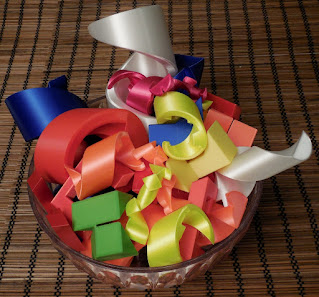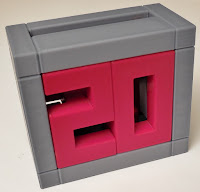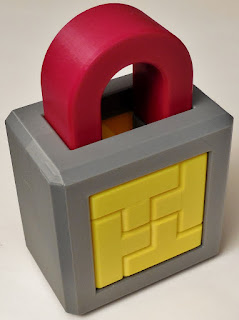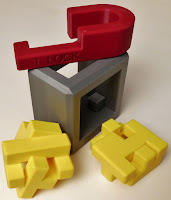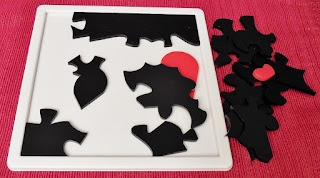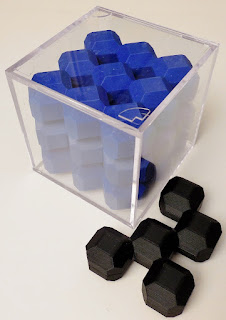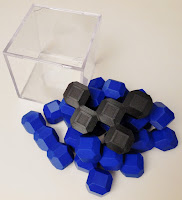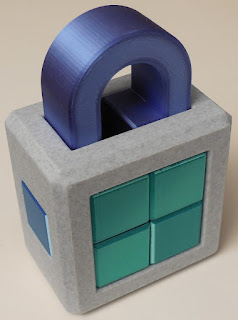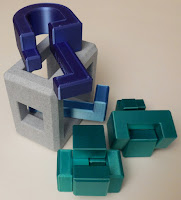On the path of exercising the mind. Expanding developing minds and preserving more mature ones.
Wednesday, August 31, 2022
A Tray Too Big – Jigsaw 16
Jigsaw 16 is a 2D packing puzzle designed by Yuu Asaka, who has developed a series of jigsaw puzzles, each with their own twist. The puzzle is made from laser-cut acrylic. It comes with a white tray consisting of 16 recessed areas in the shape of jigsaw puzzle pieces and 16 blue jigsaw puzzle pieces that have to be placed within the recessed areas. Of course, you will quickly discover that the recessed areas are a bit too generous and support the placement of more than one piece. And no - the additional space added to the recessed areas wasn’t meant to aid your attempts at placing pieces - BwaHaHaHaHa!
I started working on this puzzle as a fidget toy whilst on the phone. Starting with what looked like the hardest to place pieces, one-by-one I would try to place them in the tray. If there was no available spot, I tried to find an occupied spot that it would fit into and then find a place for the newly evicted piece. I eventually realized that I was going around in circles and that I had to energize some brain cells to focus on the problem.
Having lost its fidget toy status (sorry to whomever I hung up on), it now required some mental tracking of where the pieces could possibly be placed and then finding a placement where there is no overlap. This is basically an exact cover problem for the piece placements. Although it would probably be easier to create a matrix of piece and viable hole matches to select the exact cover, that would defeat the purpose of converting the math problem into a puzzle.
So, I continued to attack the puzzle as … a puzzle. The solve was broken into 3 main stages. Place the most finicky pieces first (the ones with 2 prongs on adjacent sides). Once those 6 pieces were in place, I tackled the other 5 finicky ones with 2 knobs on opposite sides, which required bumping some of the pieces of the original set. With all the finicky pieces out of the way, I expected the rest to fall in place without much of a fight. Although the next 6 1-tab pieces were easier to place, it did require bumping some of the finicky pieces. In case you haven’t noticed, there are various accepted labels for the male bits of puzzle pieces. The final, decidedly feminine, piece was then added.
The most difficult part of Jigsaw 16 is figuring out that there is a second challenge. It’s not mentioned anywhere, but a picture on the back of the packaging shows some of the pieces connected to each other. It turns out that the 16 pieces can be assembled into a square. Please feel free to laugh here, but I thought that this would be easy. It’s no easier than placing the pieces in the tray. In fact, its comical seeing how 15 pieces can be joined leaving a space that doesn’t match the final piece. After much backtracking, I finally had a complete square.
For me, both challenges of Jigsaw 16 fell into the grind-it-out category. I didn’t find an elegant method to solve this puzzle but I was very impressed with the design. Especially since it had 2 difficult challenges.
Wednesday, July 6, 2022
Not So – Safe
Now that we’ve established that the goal is to remove the trapped euro by traversing the maze, let’s take a closer look at the puzzle. It’s designed by Jürgen Reiche and made from laser cut wood and acrylic with 3 pins holding it together. There are 5 layers to the puzzle. The top layer is made from clear acrylic and has the puzzles name engraved on it as well as 100 equally spaced tic marks around the outer edge. There are also counts for the tic marks at every even multiple of ten. The second layer is mostly wide open to view the lower layers with the maze. However, it does have a circular area that holds the euro in its starting position under the acrylic top. There are also 4 knobs around the outside to help steady the puzzle as you rotate the maze layers. Each of the next 2 layers contains a maze. The top one is acrylic and the bottom one is a dark wood so that you can easily see both. Each of the maze layers has 2 knobs that stick out to make it easier to rotate the layers. One knob from each maze layer has an arrow engraved on it. I didn’t use the arrows, but you can use them with the tics on the top layer to generate a numeric combination for solving the puzzle. The final layer is made with a light colored wood to make the second layer maze easier to see. Each maze layer as well as the bottom layer has a circular area that can hold and pass a 1 euro coin.
So how does the maze work? The center pin is fixed and allows the maze layers to be rotated and the two outer pins can move radially in and out between 3 positions. However they can only move if the 2 maze layers are aligned to both allow the movement. Also, the maze layers can only rotate if the pins are positioned to allow it. Traversing the maze is then a series of movements with the 2 outer pins and 2 maze layers. Once you have that all down, you just need to manipulate the maze so that the 1 euro coin drops down through the layers, one at a time, until it pops out of the bottom.
Returning the euro back to the starting position is almost the reverse of releasing it. However, letting the coin drop down between the layers is ever so slightly easier than levitating it back up.
Puzzle Master gives this puzzle a rating of 10 out of 10. I’m assuming that’s for the puzzle’s appearance and not for its difficulty. As far as laser cut puzzles go, Safe is very attractive. However, I did not find it “Sehr schwierig !” as indicated in the directions and Puzzle Master's rating. The maze is rather simple to traverse and I found it more of a fidget toy than an engaging puzzle. Perfect for something to fiddle with when you’re on the phone, like I did.
I should mention that there is one point during the solve where you may be tempted to force a move since it is very close to allowing a move, but don’t do it. Keep going and look for the correct path that requires no force. Ideally, these “almost valid” situations are worked out in the design phase to remove temptation. Then again, there does appear to be a market for Youtubing puzzle brutality.
At this point, I have to admit to being a little lazy. I mentioned at the beginning that it looks like you can take the puzzle apart. If that’s true, there is nothing to keep you from assembling it differently. In fact, it looks like you can put it together 32 different ways keeping the order of the layers the same, although I believe that half will have the mirror solution to the other half. If you’re more industrious than me and have some feedback on whether there are other working configurations, let me know.
Wednesday, June 29, 2022
Arranging Your Balls - Pyradox
The summer of 2018 was a time of many fine things, the foremost being the Edward Hordern Puzzle Exchange at IPP 38 in San Diego. Amongst the many enticing entries was Pyradox exchanged by George Bell, designed by George Bell, made by George Bell, and packaged by George Bell. I’m specifically calling out the packaging since it’s nice and compact and well laid out within a transparent box.
Packing balls in tight spaces is a niche area of spatial mathematics and ball packing master George Bell has written several articles concerning this topic. CFF Issue 94, July 2014, includes George’s article on the development and analysis behind Pyradox – Pyradox: A Pyramid Packing Puzzle. The article also describes how George paradoxically accomplished the impossible when creating this puzzle.
Pyradox consists of 5 plane looking pieces and 3 coasters. The objective is to fulfill your prayers by fully filling the holey coasters with a pyramid. Each polysphere piece consists of 4 wooden balls glued together with colored bands. Each of the 3 colors used, red, blue, and green, identifies a unique piece shape. On careful inspection, you will notice that one of the 3 types of shapes is different, which may be useful when solving the puzzle. The 3 base plates are made from laser cut wood with Pyradox engraved on each and I don’t really recommend that you use them as coasters.
Each base plate provides a different pyramid building challenge. To make it easier for you, one utilizes hexagonal close packing, one a face-centered cubic packing, and the last a warped face-centered cubic packing. You’re welcome!
George did an amazing job discovering how the same 5 pieces can be used to construct 3 different pyramids with different packing geometries. I found each to be fun, non-trivial, and not too difficult. Copies are occasionally available on George’s PolyPuzzles Etsy shop. Get one and have yourself a ball.
Wednesday, June 22, 2022
Some Puzzles Give You The Shutters – W-Windows
W-Windows is an apparent cube packing puzzle designed by Osanori Yamamoto and made by Pelikan Puzzles. In this case the box has 2 large 2x2 windows that need to be shuttered (i.e., filled) and 2 of the 3 zig-zaggy pieces have a W theme going on. The box is made from Apple and the pieces are made from Ovangkol. Usually, I don’t talk about the types of woods used to make puzzles, but since I had to look up Ovangkol in my wood book (Wood! Identifying and Using Hundreds of Woods Worldwide by Eric Meier from the online The Wood Database), it’s worth mentioning that it’s another name for Shedua. However, Ovangkol is the title for the wood description and Shedua is only mentioned in the comments. Apparently Ovangkol is used by guitar makers who have better lobbyists than puzzle craftsmen.
After having done many of these types of puzzles and looking at the pieces for W-Windows, I expected:
- All pieces will be used to fill the windows.
- The W pieces will be added with some variation of an insert-shift-insert movement. Sorry to state the obvious
- One of the Ws has a 2x2 face, which obviously fills one of the box windows. It’s so obvious that it can’t possibly be part of the solution. Or could it?
- The tetracube piece will be in the center somewhere moving around to allow the W pieces to slowly emerge from the box.
- Each W piece will be associated with its own window.
- The tetracube piece will have the highest move count.
I freely share these expectations with you because they are of no help whatsoever when solving the puzzle.
When I first sat down with the puzzle, I took the approach of looking for an assembly and then determining whether it could be placed in the box. I learned 2 important things from this approach: 1) There are too many assemblies, and 2) There are a lot of ways that the pieces cannot be oriented within the box. It’s definitely worth the time to determine how the pieces can and can’t be oriented within the box so that you can quickly recognize a possible assembly from an impossible one.
When looking for the solution, I try to find an assembly that looks like it has a few good moves. These types of puzzles usually don’t have deep false paths, and once you find something that looks interesting, it’s frequently the solution, which was the case with W-Windows for me.
It may be the eternal optimist in me, perhaps the stubbornness, or more likely the short-mindedness, but I looked at the 2 big windows of the box and the 3 measly pieces and thought that this would be a quick score. However, those simple pieces kept me entertained for about an hour and I did enjoy the solution once I found it. You really can’t go wrong with these apparent cube packing puzzles from Osanori Yamamoto. Thankfully, Osanori creates new ones faster than I can acquire and solve them.
Wednesday, June 8, 2022
Puzzle Philosophy - Yin Yang
Yin Yang was developed by Volker Latussek and made by Pelikan Puzzles. The box was made using Cherry and has a Maple (Yang) top to contrast nicely with the 6 Wenge (Yin) pieces. When all the pieces are packed in the box, you end up with a nice digitized taijitu symbol.
Upon inspection, 4 of the Yin pieces are symmetric and the other 2 are not. These asymmetric pieces are the key Yin and Yang pieces. I know that I stated that the Wenge pieces were the Yin to the box’s Yang, but even when you separate them, you still have both in each. Yeah, it doesn’t make a lot of sense, so let’s just agree to call it a principle and keep building on it. Now that we have our key Yin Yang Yin pieces, as long as they aren't symmetrically situated within the assembly, these mystical keys can be used to affect a transformation between Yin and Yang assemblies. You’ll also notice that extra effort went into highlighting that each piece was constructed by combining a 2x3 block with a 1x2 block. I suppose one of those would be the Yin and the other the Yang requiring the key pieces to be formally referred to as the Yin Yang Yin Yang Yin pieces.
.jpg) |
| Yin and Yang |
I’m embarrassed to admit it took longer than expected to find a 4x4x3 assembly. Of course once I found it, it had to be the required assembly and I was never going to let it go. I could see how the first 3 pieces would come out and only had to figure out how to release the remaining 3. Surely, taking out (Yang?) / putting in (Yin?) 3 pieces with all that space couldn’t be that hard (With all my experience with 3D apparent packing cubes, it’s a wonder I can still think that). Needless to say, I spent a considerable amount of time experimenting with some amazing cramming techniques with those obstinate pieces until I remembered the principle of the whole thing and immediately solved it.
Wednesday, May 11, 2022
Petite Passel of Puzzles – 2D Packers
I recently received a passel of 2D packing puzzles from a very generous member on the Mechanical Puzzles Discord (MPD). These puzzles make great fidget toys when on the phone. On a recent call, I found that I went through 5 of them in rapid succession. To be completely honest, I was pulling the ones that looked easiest while on the phone. The days of deluding myself by thinking that I can focus on 2 things at the same time have passed.
The puzzles of the petite passel of 2D Packers described here have several things in common. The goal is to place a set of pieces that lay flat within a frame with a restricted opening top. They are made from layers of laser-cut acrylic and the frames are held together in the corners by metal hardware. Each puzzle has its own unique set of identical pieces.
Doheny
Doheny was designed by Haym Hirsh and made by NothingYetDesigns. Of the petite passel, this one had the best construction with 2 layers of extra thick green acrylic topped with a thinner piece of clear acrylic. The layers of acrylic are held together by hex socket bolts with capped hex nuts on the bottom to provide a nice set of legs that won’t scratch furniture. Small washers are included both on top and bottom. A slightly thicker washer is included between the clear and green acrylic layers to ensure that the pieces can move freely under the acrylic top once they are inserted. The 6 pieces to be inserted were made with thick white acrylic to provide a nice contrast with the green frame. I really like that the name, designer, and shop logo are engraved on the bottom of the clear acrylic. I don’t know the genesis of the puzzle’s name, but I’m sure that there is a reason for it. If you know or have a guess, you can include it in a comment.
At first glance, this puzzle looked like it would be the most difficult of the group and in fact it was, but none of these puzzles provided a difficult challenge. Pretty soon after looking at the pieces and the space that they needed to occupy, I came up with a way to lay them out. It was a simple matter to then insert the pieces.
C-It
C-It was designed by Haym Hirsh and made by NothingYetDesigns. The construction is similar to Doheny except that the hardware is black instead of silver and the only washers used were the 4 for the layer spacing. The top screws also have a lower profile. C-It was made with a blue frame and black pieces with very little contrast between them. The name for this puzzle is a bit more obvious than Doheny. If you can’t see it, look at the pieces and the frame again. The solve is straight-forward and due to the symmetry of the pieces you don’t even have to worry about putting them in upside-down. This puzzle is still available at NothingYetDesigns for you to seize it.
Eloquint
Eloquint was designed by Haym Hirsh and made by NothingYetDesigns. Unlike the prior 2 NothingYetDesigns puzzles, all 3 layers of the frame use thin red acrylic and the hex nuts on the bottom were open and not capped. The pieces were in light blue. The name of the puzzle and designer are engraved on the bottom without the NothingYetDesigns logo.
I solved this one and thought the solution was trivial. So I did what any experienced puzzler would do and doubted that I solved it correctly. Working at it a bit longer, I found a more complex solution (not to be confused with a complex solution) that I suspect is the intended solution. The trivial solution resulted from the extra space introduced by the spacers, which allowed for unintended piece movements.
My favorite part of this puzzle is the name and I find it a shame when I see descriptions of this puzzle referring to the 5 V pentominoe pieces.
Skinny and Fat Lightning?
Unfortunately, I received these puzzles second-hand and have no information on them including names, designers, creators, and shops. How embarrassing! My guess is that the information is the same for both since the construction looks similar. The major difference between them is that one has a green frame with brown pieces and the other has a brown frame with blue pieces. All of the frame layers use the same thin acrylic. The tolerances on both were well done to allow the movements required to solve the puzzle. The hardware used to fasten the frame layers used simple phillips head screws and hex nuts. Unfortunately, some of the screws stick out on the bottom and have sharp edges that will scratch furniture if you’re not careful. Unlike the NothingYetDesigns puzzles, spacer washers are placed between the 2 colored layers of acrylic instead of between the clear and colored layers of acrylic. I noticed that this had the benefit of keeping dust and other particles from getting between the clear and colored layers.
It’s obvious that I took great liberties in providing names for this description. My apologies to all parties concerned. If you have any information on these puzzles, please post it in the comments.
Neither of these puzzles will stump you for long and they both provide a similar experience. Lightning only strikes once and after you solve one, the other will lack the same impact. If you get both, I would recommend avoiding solving them at the same time.
Wednesday, May 4, 2022
Happy Anniversary! – Yet Another Year of ZenPuzzler
ZenPuzzler has reached the end of its third year. Readership has increased by 25% thanks to the arrival of my brother’s first baby. After discovering that it immediately puts the baby to sleep when my brother reads the blog out loud, he finally relented and subscribed to the blog. The subscriber base is now holding at a steady 5. Hopefully, next year will see another increase of 25% as I promote the blog as a cure for insomnia.
To wrap up the year, I have created a list of the posts and the puzzles that are mentioned in each. This year included puzzles made from exotic woods and colorful plastics (printed and cut) as usual, but also saw the addition of a book this year. Hopefully, there will be more books forthcoming in the future. The name of each post is linked to the entry so that you can easily jump to it by clicking on the name.
20 APR 22 – Solve Before Midnight - Pumpkin 1
- Pumpkin 1 by Osanori Yamamoto
6 APR 22 – Are You Worthy - Enter If You Can
- Enter If You Can, The art of puzzle boxes by Peter Hajek
.jpg)
Puzzle Knowledge
30 MAR 22 – A Particlely Nice Puzzle - XI
- XI by Haym Hirsh
23 MAR 22 – Going Postal – Letter Box
- Letter Box by Pit Khiam Goh
16 MAR 22 – Puzzling Preparation Purgatory – Helical Bits and Pieces
- HeLLical Burr by Derek Bosch
- Oliver Twist by Derek Bosch
- Twiddle Dee by Derek Bosch
- Twiddle Dum by Derek Bosch
- Dodekastar (improved) by Yavuz Demirhan, tweaked by the Two Brass Monkeys
9 MAR 22 – Puzzle Of A Year! – 20-22
- 20-21 by Stéphane Chomine
.jpg)
Puzzles in Plastic
16 FEB 22 – X-tra Protection – T Lock
- T Lock by Andrew Crowell
9 FEB 22 – Happy VD! – Broken Heart
- Broken Heart by Techno Angels and Bozoou
2 FEB 22 – Wonderizing Puzzles – Benno’s TIC 2.0
- Benno’s TIC 2.0 by Benno de Grote and Andrew Crowell
26 JAN 22 – Where Does That F’n Piece Go! – Melting F
- Melting F by George Bell
19 JAN 22 – Put It To The – Side Lock
- Side Lock by Andrew Crowell
12 JAN 22 – Say Hello To – Goodbye
- Goodbye by Tomas Vanyo
5 JAN 22 – Not a Box For Tea, A – T-Box
- T-Box by Haym Hirsh
.jpg)
Puzzles in Wood
27 OCT 21 – Shhhh! She Just Turned – 6T
- 6T by Ken Irvine
8 SEP 21 – A Puzzle to Save the Day - Mighty Pin
- Mighty Pin by Alan Lunsford
4 AUG 21 – Tooling Around With Puzzles - Sequential Discovery Cubic Box
- Sequential Discovery Cubic Box by Junichi Yananose
28 JUL 21 – An Acute Case of Soma Mangling - Halfcut Soma
- Halfcut Soma by László Molnár
15 JUN 21 – BBQ With Charcoal
- BBQ Basket by Akaki Kuumeri
- Charcoal Basket by Akaki Kuumeri
26 MAY 21 – Need An SD Fix? CD With The - ResQ
- ResQ by Frederic Boucher and Eric Fuller
Wednesday, April 20, 2022
Solve Before Midnight - Pumpkin 1
Pumpkin 1 was designed by Osanori Yamamoto and made by Pelikan Puzzles with a Pear box and Bubinga pieces. It is an apparent cube packing puzzle (i.e., the opening of the box is completely filled and any empty space is hidden within the box).
There are a few ways to address the solving process for these types of puzzles. The first is to find an assembly for the pieces and then test the assembly against the disassembly that is constrained by the opening of the box. This works best when there are a small number of assemblies. They usually have a smaller number of pieces as well as a smaller number of voids in the solved cube. Pumpkin 1’s 3 pieces certainly meet the small number of pieces criteria, but there are 9 voids within the solved puzzle. Playing with the pieces, there seemed to be a surprisingly large number of ways to assemble them within a 3x3x3 space. After solving it, I checked with PuzzleWillBePlayed (PWBP) where it indicated that there are 54 assemblies with only 1 of the assemblies provides a working solution.
Another way to tackle the problem is to determine how the pieces can be inserted within the frame through the restricted opening. However, with Pumpkin 1’s wide open corner, there isn’t much that isn’t allowed. And yet, it’s not easy to get all the pieces in there as an apparent cube.
At one point, I was hoping that I was correct in assuming that it really was an apparent cube puzzle since I had found at least one solution where all the pieces went in, but there was a visible void. While we’re talking about making assumptions, I wasn’t aware of the puzzle’s level while solving and was assuming that it took more than 1 move to remove the first piece, which is true for most puzzles of this type.
I finally decided to tackle this particular puzzle by working it from the other end and testing how pieces may move in sequence to release them from the box. For the first move, does the piece start to come out or does it go further in? Does 1, 2 or all 3 pieces move together at the same time? How would that movement allow another piece to move? Rinse and repeat.
The pieces do allow for some interesting movement. At one point, I discovered an interesting sequence of moves that seemed to have promise. Unfortunately it wasn’t the solution I was looking for. I kept searching for other sequences but couldn’t find anything else even close. I kept going back to that sequence of moves and tried to find ways to tweak it into submission. Sadly I couldn’t find anything else. Even sadder, it was the real solution but I failed to recognize it. As it turned out, I could have solved it before midnight if I had paid better attention. That’s the danger of working outside the box. Sometimes there’s a difference between the virtual world and the real world.
I also learned on PWBP that there are 2 other Pumpkin designs by Osanori – strategically named Pumpkin 2 and Pumpkin 3. After looking at the other 2 designs, I couldn’t find a similar feature that relates them. However, Osinori generates so many designs, I can’t blame him for genericizing the naming process.
Wednesday, April 6, 2022
Are You Worthy? – Enter If You Can
Enter If You Can, The art of puzzle boxes is a new book by puzzle box collector and designer, Peter Hajek (ISBN 978-1-5272-8215-5). After many decades of research on addiction, Peter finally decided to write a book about his own. Within, Peter shares a wealth of puzzle box knowledge gained from his experience as a longtime collector and his frequent puzzle box hunting expeditions around the world. The book provides a brief history of puzzle boxes, a survey of different puzzle box styles and their tricks, and a cross section of puzzle box designers from around the world. I should warn you that the solutions to several of the puzzle boxes included are revealed and discussed.
The book is well-written, informative, and full of beautiful photos of a large variety of puzzle boxes. Its greatest failure (or strength) is that the reader is left wanting more. In fact, I would have enjoyed an entire encyclopedia on the subject matter with each chapter becoming a book of its own. Of course, this is a characteristic of a well-written book and I’m certainly looking forward to the next one.
The book is available in 2 formats – book only and book with lock. The locked version ensures that the petitioning reader is worthy of receiving the knowledge within and incorporates a strap attached to the back cover that connects to a lock attached to the front cover. Of course it is a puzzle lock that has to be solved to open the book. The lock was designed and made by Master Locksmith, Shane Hales of Halespuzzles.
As of this writing, the book without the lock is available at Cubicdissection and the locked version is available at Puzzle Master. Pelikan Puzzles offers both versions of the book together as a set in case you want the locked copy but also require an easy access version if you feel you may not be worthy. Both versions are also individually available from Grand Illusions.
Wednesday, March 30, 2022
A Particlely Nice Puzzle - XI
XI is a restricted opening 2D packing puzzle designed by Haym Hirsh and made by NothingYetDesigns. The 2 openings in the top permit the XI and anti-XI particles to be injected within the frame. The anti-XI particles are simply XI particles with a 180 degree spin. Although the 2 openings conspire to suggest that both XI and anti-XI particles should be injected, it is not obvious how many of each is required or even if both types are needed. Even if each anti-XI particle cancels out a XI particle as they bounce around and collide with each other, the odd number of particles suggests that the solution will eventually end up as a XI or anti-XI puzzle. I leave it up to you to find out which.
Needless to say, the particles need to be added in a specific order and potentially rotated as they are entangled. It’s nice that the top is clear so that you can see what you are doing. Of course, you have to perform all those particle movements and rotations using the 2 openings. Fiddly, but not that difficult. However, if you regularly refer to your digits as sausages, you may find the physics of manipulating small particles more of a challenge.
XI is made with laser cut acrylic and has a nice heft to it. The use of washers to elevate the clear top ensures that the 5 particles move nicely within the frame. The puzzle information engraved on the top is also well done and useful for distinguishing the puzzle from other restricted opening 2D packing puzzles by Haym from NothingYetDesigns.
Wednesday, March 23, 2022
Going Postal - Letter Box
All the letters that you will be stuffing in Letter Box are copies of the L tromino - 9 of them. They all have to be inserted through the small slot. When solved, the 9 L trominos will completely fill the Letter Box.
Letter Box, designed by Pit Khiam Goh, was made by Cubicdissection and released in December 2020. The box is made from Walnut and each of the L trominos is made from a different exotic wood: Wenge, Canxan, Jatoba, Zebra, Bloodwood, Purple Heart, Katalox, Chakte Viga, and Ash. It’s especially nice that each of the L tromino pieces is made from a single piece of wood. In addition to the slot that permits the L trominos to pass, there are 2 additional holes that can be used to view and manipulate the pieces within the box.
There are many ways to tackle a puzzle. Since this puzzle has 2664 assemblies, I wouldn’t recommend an exhaustive approach to try each one until you find one that works. Even if you found a working assembly, it may not be obvious since the solution requires rotating pieces within the box. For this puzzle, a better approach would be to start at the other end and envision how the pieces would be removed from the box. How would the first piece come out? Then with the first piece out, how would the second piece come out? Using this approach, I was able to find a workable assembly and determine the rotations needed to solve Letter Box. Not overly difficult but a very nice challenge.
Wednesday, March 16, 2022
Puzzling Preparation Purgatory – Helical Bits and Pieces
Puzzles arriving in their solved state is a sin and need to be disassembled into purgatory before being redeemed into a solved state. Although a sinful puzzle and one that has been redeemed share the same outward appearance, deep down, you know the difference. Every serious puzzle collector is able to scan their collection and weigh their sins against redemption.
Having received this batch of sinful puzzles, I quickly (or not so quickly) banished the puzzles to purgatory (a nice looking decorative bowl) for all eternity (the average amount of time it takes me to get around to solving puzzles). Most were straight-forward, but one of the Twiddle twins (I really don’t know which is which), was a bit of a challenge. I was also surprised to find out that Dodekastar was a challenge to take apart as well. A lot of movement, but no obvious exit point.
Stay tuned for further updates on these puzzles as they are redeemed and take on their divine forms.
Wednesday, March 9, 2022
Puzzle Of A Year! – 20-22
20-22 is a level 22.02 puzzle announced on Twosday, 22.02.2022, by PuzzleWillBePlayed (PWBP). It was designed by Stéphane Chomine and consists of 2 pieces that fit within a frame. When solved, one side shows the numerals 20 and the other 22.
I always check out the new puzzles released on PWBP and this one caught my eye and interest. I quickly printed a copy with a gray frame and red pieces. One piece has a 2 on each side and the other has a 2 on one side and a 0 on the other. Of course, the frame has some internal obstructions keeping the pieces from simply sliding in. Must be a puzzle.
This puzzle embodies several qualities that facilitate the solving process. The first is the level. At 22 moves, you would expect it to be non-trivial but not too hard. The second is that the piece with a 2 on each side is the same when you rotate it 180 degrees on any axis. That means that you can’t possibly add this piece incorrectly. You just need to figure out which side of the frame it belongs to. Lastly, since the piece with the 0 can go in the frame in four different ways, there are only 4 assemblies to check. With a little experimentation, the complete pas de deux is revealed as the pieces find their final resting place.
A special thanks to all the MPD’rs that unknowingly contributed to this post.
Wednesday, February 16, 2022
X-tra Protection – T Lock
Like Side Lock (www.zenpuzzler.com/2022/01/put-it-to-side-lock.html), T lock has a main frame (for all you old programmers out there), a shackle, and 4 T pieces that are packed in the frame. The pieces are nicely 3D printed in gray, red, and yellow. Since it doesn’t have the fifth piece running side-to-side like Side Lock, I expected it to be slightly easier. Of course, it turned out to be slightly harder. T Lock requires 15 moves to remove the first piece compared to 19 moves for Side Lock, but T Lock requires a rotation, which gives it that boost in difficulty. Recall that puzzle difficulty = cube root of total voxels * pieces * highest piece moves * log(10 + rotations * 100) / 100. {Factors to compensate for things like n-ary inflation have been dropped for simplicity. Compensating factors for piece surface area have also been removed since they are a pain to compute. However, for designers that needlessly increase voxel resolution, these factors should be added back in.}
I’d like to describe how easy the original disassembly was, but it was so long ago I can’t remember. This became all too obvious as I worked to get it back together. In fact, I forgot that a rotation was required, which really is the crux move of this puzzle. Needless to say, accomplishing the solve was a challenge.
The frame has 3 impeding cubies attached inside to help you figure out where you can, or more appropriately, where you can’t, put pieces. These cubies only permit the shackle to be inserted in one orientation, so you can also add the shackle to places where pieces can’t go. With some work, you can then determine where the 4 T pieces go, although I admit to doubting this configuration many times and re-examining it. Trying to get those 4 pieces in the frame took some effort. Once I finally figured out which 2 pieces needed to go in first, I had a devil of a time trying to get them situated in the frame.
Typical Crowell puzzle scenario – struggling to get 2 small pieces in a big open frame. Been there many times. This is where I spent most of the time in the assembly until I finally enjoyed the Aha moment that resulted in not just the first 2 pieces in the frame, but all 4.
T Lock is difficult and very satisfying as an assembly puzzle. Having done it several times now, although not as difficult as an assembly puzzle, attacking it as a disassembly puzzle is interesting as well. You can get copies of T Lock on Andrew’s online store, ARC Puzzles.
Wednesday, February 9, 2022
Happy VD! – Broken Heart
It’s that time of year when love in the air and our thoughts turn to VD. Yes, it’s time again to celebrate Valentine’s Day with your special loved one on 14 February. To celebrate this special occasion, I ordered a love themed puzzle to share with my better half – Broken Heart by Techno Angels and Bozoou.
Broken Heart is a 2D packing puzzle from JIGSAWHOLIC, made with laser cut acrylic pieces and a plastic tray. The puzzle arrives in a plastic bag, which states that the level of difficulty is 6 out of 10 and that the goal is to put all 19 pieces into the frame. Seventeen of the pieces are black and two of them are red. The matte finish on the black pieces looks fantastic!
It also comes with a drawstring bag with the warning, “open after you solve the puzzle”, and feels like it contains another piece. We all know what that means! Having recently completed all three original Magic Puzzles, a morphing surprise was certainly expected.
In the true Valentine’s spirit, I solved the puzzle with my wife. We both started putting puzzles pieces in the tray and in less than 5 minutes, we had all 19 pieces in the tray with an obvious piece missing. Opening the drawstring bag, we took out the final piece and added it to the tray. What gives? Where’s the magic? Where’s the Aha moment?
If you do enough puzzles, you realize that sometimes you just get lucky and stumble upon the solution right away and miss out on the brilliance of the puzzle. So I spent some time examining the pieces to find what I had missed. Unfortunately, I wasn’t smart enough to discover the genius behind this puzzle. I’m currently under the impression that the Aha moment is to realize that you need the configuration that we discovered at the beginning. There is a little effort to lead you away from this configuration, but there is an even greater pull to bring you towards it. To be fair, the website does warn that 30% of the people are not going to experience the “twist”. In the end, it’s a nicely made jigsaw puzzle that may help you score (some points) on Valentine’s Day.
If all you are looking for is a quickie on Valentine’s Day, a Broken Heart may be just what you deserve.
Wednesday, February 2, 2022
Wonderizing Puzzles – Benno’s TIC 2.0
George was fascinated by a puzzle designed by Benno de Grote called Favorite. It is level 7 puzzle and George was interested in knowing if the complexity could be increased. To scratch that itch, he shipped the design off to Andrew Crowell to pass it through his Magical Puzzle Wonderizer. For those of you unfamiliar with the Andrew’s Wonderizer, it takes a plain puzzle design as input, breaks it down to its core puzzle DNA, injects complexity steroids, and reconstitutes its components into its new uber form. So what would happen if you put in a design that was already great to begin with? Would it strip out the elegance and produce a quotidian block of wood? As it turns out, the Wonderizer took the level 7 puzzle and produced a level 16 puzzle with some added rotations sprinkled in, which was summarily named Benno's TIC 2.0.
For a long time now, George has been posting enticing photos of the puzzles that he has been making, whetting everyone’s appetite for more wooden puzzles. Certainly not immune to that allure, as I gazed upon the photos of Benno’s TIC 2.0, I said to myself, “I’d love to give that puzzle a try”. And then I moved on since they were not being produced.
Several weeks later, I received a package. A package from my good friend George. A package that contained a single cubic box. The kind of nondesript white foldup box that puzzles sometimes come in. Inside this box was, you guessed it – some foam wrapping! Yes!!! Foam wrapping! That's such a good sign! And sure enough, protected by that foam wrapping was Benno’s TIC 2.0 that I saw on the MPD. WOW!!!
Instead of drooling over pictures on the MPD, I now had one in hand. TICs are my thing and…I can’t find the first move. That first piece fits snuggly in the cube and took a couple of minutes to locate. After a couple more moves, things start to open up and you may find that you are going in circles. However, once you break out of that circle, pieces start emerging from the cube.
The dance required to separate the last 3 pieces was particularly nice. Looks like it would be easy, feels like it’s impossible, and is greatly appreciated when you finally successfully traverse the correct path. Need I say that the path is a bit twisted.
Reassembling the puzzle right after disassembly while all the moves are fresh in mind is easy. It is much more interesting to leave it unassembled and tackle discovering the moves in reverse.
Since I don’t have a copy of the original Favorite design by Benno, I can’t comment on the differences between the original and the wonderized version. I can say that the Benno’s TIC 2.0 is a great design and fun to solve. Thank you George! Thank you Andrew! Thank you Benno!
Wednesday, January 26, 2022
Where Does that F’n Piece Go! - Melting F
Hold on – there’s another piece in the shipping box that it came in. Surely, it doesn’t go in the case with the other 9 pieces. Since it’s bigger and oddly shaped, maybe it’s supposed to replace one or two of the other pieces. However, having worked with a puzzle or two and the fact that the word melting is in the name, I suspected that the additional piece had to be crammed in the case with the other pieces. You may be tempted to just torch that F’n piece and drip it in between the other pieces, but as puzzlers we’re all about doing things the hard way.
Melting F was made by geometric puzzle packing genius, George Bell, and was his entry in the 2020 Nob Yoshigahara Puzzle Design Competition. This new design is a truncated rhombic dodecahedra packing exercise. The puzzle consists of 10 3-D printed pieces that need to be packed within a clear acrylic display case. The 9 identical blue pieces are made from 3 truncated rhombic dodecahedra while the single F piece is made from 5. You have to squint really hard to convince yourself it looks like an F.
The initial step with these types of puzzles is to determine the type of packing used – in this case, how the truncated rhombic dodecahedra are oriented within the space defined by the display case. This then defines how the pieces can be oriented within the case. Then comes the hard part – determining where the pieces have to go. Although this is not overly difficult, it does take some experimentation to find the solution.
I liked the fact that nine of the pieces were simple identical shapes. It drops the level of complexity and makes the design approachable for any level of puzzler. It also displays nicely in the clear acrylic display case. Melting F can be acquired from George’s PolyPuzzles Etsy Shop when in stock.
Wednesday, January 19, 2022
Put It To The - Side Lock
The first thing that surprised me when the puzzles arrived was how big they were. They were twice as big as I was expecting, providing a nice heft for 3D printed puzzles. The puzzle consists of the frame and 6 other pieces: 4 short burr pieces, the longer burr side piece, and the shackle. As expected from puzzles 3D printed by Andrew, the fit and movement of pieces is excellent. The puzzle is also quite attractive, made using a marble-like filament for the frame and shiny blue, green, and purple filament for the pieces.
Since Side Lock arrived assembled and my preference is to attack these types of puzzles as assembly challenges, I quickly disassembled it and planned to leave the pieces untouched for a couple days while any vestiges of piece movement memory quickly decayed. Quite honestly, at this point in my life, anything over 5 minutes is overkill. A couple of months later, I found the pieces and attempted the reassembly.
With an empty frame and 6 pieces, I began tackling the reconstruction of Side Lock. There is a feature within the frame that matches one of the pieces thus revealing the location of the first piece. With the location of the first piece known, the location of the next piece becomes obvious. At this point, I’m thinking, “This is easy, only four more pieces to go!”. However, this was the end of Easy Street forcing me to kickstart that old clunker of gray matter. Where once the old brain could breeze through these problems, I can now feel it wheeze through the process. Eventually, the pieces found themselves in the shape of a lock once again.
I really like these lock shaped burrs and at 19 moves to remove the first piece, it’s a nice little challenge. The one thing that I would like to see changed with the puzzle is to have the name debossed on the outside instead of on the shackle hidden in the frame. I like to be able to reference the name without having to disassemble the puzzle. However, I realize that this is my personal opinion and that there are people that don’t care to have the outside of their puzzles defaced with any type of lettering.
Wednesday, January 12, 2022
Say Hello to – Goodbye
Hello Goodbye!
Yes, we could have wrapped up this blog entry right there but I felt compelled to add some other details. Goodbye is a puzzle designed by Tomas Vanyo and made by NothingYetDesigns (NYD). It’s made from laser cut acrylic with a bolt in each corner to keep it all together and includes a little wooden piece made from Cocobolo. What really caught my attention was the matte black finish on the face with the white lettering. It has such a clean look to it. I also liked the clear mazes but they were a real challenge to photograph. The little wooden piece was made for NYD by Nedeljko Woodworks. It’s always nice to see these types of collaborations within the puzzle community.
The puzzle consists of two maze plates that move in opposite directions within a frame. These maze plates are kept in the frame by the small wooden piece that traps the plates within the frame as well as being trapped itself by the plates. The goal of the puzzle is to determine how to manipulate the pieces within the frame to remove them.
Zig, zag, zig, zig, zag, zig, zag, zag … and 181 moves later, you can remove the trapped wooden piece. It’s not very difficult and you are never in any danger of getting lost. There is also an Aha moment to be enjoyed – no it’s not the fact that you can unscrew the fasteners to take it completely apart and reorganize it.
If you want to continue exploring other possibilities with Goodbye, the maze plates can also be placed within the frame in other orientations. The 181 move orientation that the puzzle arrives with is the maximum number of moves of all the plate combinations.
After the initial release, NYD posted a message on the Mechanical Puzzles Discord (MPD) server indicating that that the puzzle configuration was not optimum for displaying the puzzle after it was solved. It turns out that the puzzle stands up nicely on the edge of the frame, but the engraved wording on the puzzle would be upside-down. NYD indicated that this could be rectified by simply undoing the fasteners and rotating the engraved plate by 180 degrees.
I did rotate the faceplate of my copy of Goodbye and it does display nicely in that orientation. Of course, puzzle orientation is a funny thing. When you start working on a puzzle, you eventually establish what you consider is the orientation for the puzzle. Someone else may have a completely different orientation from you and you might find it odd watching someone else solve it. Since Goodbye comes with the name, designer, and maker on it, it provides a strong sense of which direction is up and which is down. Having already established an orientation of the puzzle before switching the faceplate around, I continue to solve the puzzle in the same manor – now with the words upside-down.
Wednesday, January 5, 2022
Not A Box For Tea, A – T-Box
About the same time that I gave my wife her 6T birthday puzzle, I acquired a copy of T-Box, which, pointed out by my wife, also has six T-shaped pieces in a box. T-Box was designed by Jenga master, Haym Hirsh and made by Mom – no, wait, I had it upside-down - made by Brian Menold at Wood Wonders. This is the latest of Haym’s designs inspired by Jenga pieces. For some, Jenga is a multi-player stacking game with wooden pieces, for others it is a source of raw materials for puzzle making. Hopefully, we won’t see a massive run on Jenga blocks resulting in the worldwide shortages that we saw with tongue depressors (Chico Strikes Again – TD345).
Brian Menold turned the T-Box design into a stunning showpiece. The pieces were upgraded to Birdseye Maple and the box was made from Bloodwood with a Maple Top. What really makes this box stunning is the detailed laser engraving on the sides of the box. Brian is fortunate to have a gifted graphics artist in the family and the design created for the T-Box really makes it something special.
Of course the goal is to get all 6 pieces within the box so that the top lays flush with the sides. To help, or perhaps to hinder, there are a few impediments attached to the interior of the box. Solving the puzzle is not that difficult, but it is a nice challenge. When I was done, I noticed a nice property of the pieces, which can be exploited to solve the puzzle. I’d like to say that, of course I recognized this property and summarily conquered the challenge in one swift stroke, but as usual, I crossed the finish line with a half-lit bulb. Perhaps you’ll come across it and immediately recognize it for what it is. And no, I’m not going to say what it is.
.jpg)
.jpg)
.jpg)
.jpg)
.jpg)
.jpg)
.jpg)
.jpg)
.jpg)
.jpg)
.jpg)
.jpg)
.jpg)
.jpg)
.jpg)
.jpg)
.jpg)
.jpg)
.jpg)
.jpg)
.jpg)
